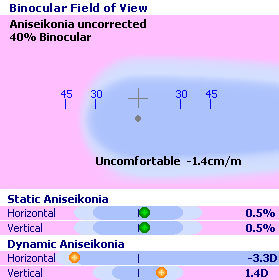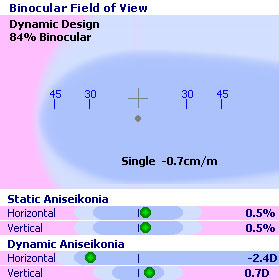Dynamic aniseikonia due to face form angle and anisometropia. Age 28.
“It never ceases to amaze me how even a small amount of anisometropia can be problematic for some patients.”
–Dr. Peter Shaw
| Sphere | Cylinder | Axis | Add | PD | |
| OD | -3.00 | 32 | |||
| OS | -2.00 | 32 |
| BU | BD | BI | BO | ||
| 1 | 1 | 3 | 8 |
| Eye | DBL | Wrap | Vertex | Height | |
| 54 | 18 | 10 | 10 | 18 |
 This patient attended with mild headaches. He was a part-time glasses wearer who always found his glasses uncomfortable, and he preferred his contact lenses. His previous spectacles, made with conventional uncut lenses, were causing an undue amount of base in prism demand on left gaze and excessive vertical prism. The SHAW lens method optimized the base curvature and specified a very minor thickness increase (about 1 mm) in one lens, and this provided all the help that he required.
This patient attended with mild headaches. He was a part-time glasses wearer who always found his glasses uncomfortable, and he preferred his contact lenses. His previous spectacles, made with conventional uncut lenses, were causing an undue amount of base in prism demand on left gaze and excessive vertical prism. The SHAW lens method optimized the base curvature and specified a very minor thickness increase (about 1 mm) in one lens, and this provided all the help that he required.



Of significance here is the restriction in left gaze due to the uncorrected dynamic aniseikonia caused by anisometropia and compounded by the 10° face form angle. Note how the SHAW lens increases the visual field from 30° to 50° in this single vision correction.